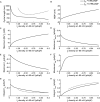Reciprocal interaction between IK1 and If in biological pacemakers: A simulation study
- PMID: 33690622
- PMCID: PMC7984617
- DOI: 10.1371/journal.pcbi.1008177
Reciprocal interaction between IK1 and If in biological pacemakers: A simulation study
Abstract
Pacemaking dysfunction (PD) may result in heart rhythm disorders, syncope or even death. Current treatment of PD using implanted electronic pacemakers has some limitations, such as finite battery life and the risk of repeated surgery. As such, the biological pacemaker has been proposed as a potential alternative to the electronic pacemaker for PD treatment. Experimentally and computationally, it has been shown that bio-engineered pacemaker cells can be generated from non-rhythmic ventricular myocytes (VMs) by knocking out genes related to the inward rectifier potassium channel current (IK1) or by overexpressing hyperpolarization-activated cyclic nucleotide gated channel genes responsible for the "funny" current (If). However, it is unclear if a bio-engineered pacemaker based on the modification of IK1- and If-related channels simultaneously would enhance the ability and stability of bio-engineered pacemaking action potentials. In this study, the possible mechanism(s) responsible for VMs to generate spontaneous pacemaking activity by regulating IK1 and If density were investigated by a computational approach. Our results showed that there was a reciprocal interaction between IK1 and If in ventricular pacemaker model. The effect of IK1 depression on generating ventricular pacemaker was mono-phasic while that of If augmentation was bi-phasic. A moderate increase of If promoted pacemaking activity but excessive increase of If resulted in a slowdown in the pacemaking rate and even an unstable pacemaking state. The dedicated interplay between IK1 and If in generating stable pacemaking and dysrhythmias was evaluated. Finally, a theoretical analysis in the IK1/If parameter space for generating pacemaking action potentials in different states was provided. In conclusion, to the best of our knowledge, this study provides a wide theoretical insight into understandings for generating stable and robust pacemaker cells from non-pacemaking VMs by the interplay of IK1 and If, which may be helpful in designing engineered biological pacemakers for application purposes.
Conflict of interest statement
The authors have declared that no competing interests exist.
Figures






Similar articles
-
Role of If Density on Electrical Action Potential of Bio-engineered Cardiac Pacemaker: A Simulation Study.Annu Int Conf IEEE Eng Med Biol Soc. 2019 Jul;2019:3995-3998. doi: 10.1109/EMBC.2019.8856350. Annu Int Conf IEEE Eng Med Biol Soc. 2019. PMID: 31946747
-
Kir2 inward rectification-controlled precise and dynamic balances between Kir2 and HCN currents initiate pacemaking activity.FASEB J. 2018 Jun;32(6):3047-3057. doi: 10.1096/fj.201701260R. Epub 2018 Jan 12. FASEB J. 2018. PMID: 29401592 Free PMC article.
-
A Singular Role of IK1 Promoting the Development of Cardiac Automaticity during Cardiomyocyte Differentiation by IK1 -Induced Activation of Pacemaker Current.Stem Cell Rev Rep. 2017 Oct;13(5):631-643. doi: 10.1007/s12015-017-9745-1. Stem Cell Rev Rep. 2017. PMID: 28623610 Free PMC article.
-
The role of the funny current in pacemaker activity.Circ Res. 2010 Feb 19;106(3):434-46. doi: 10.1161/CIRCRESAHA.109.208041. Circ Res. 2010. PMID: 20167941 Review.
-
Biological pacemaker: from biological experiments to computational simulation.J Zhejiang Univ Sci B. 2020 Jul;21(7):524-536. doi: 10.1631/jzus.B1900632. J Zhejiang Univ Sci B. 2020. PMID: 32633107 Free PMC article. Review.
Cited by
-
A Comprehensive Review of a Mechanism-Based Ventricular Electrical Storm Management.J Clin Med. 2025 Jul 29;14(15):5351. doi: 10.3390/jcm14155351. J Clin Med. 2025. PMID: 40806975 Free PMC article. Review.
-
Understanding PITX2-Dependent Atrial Fibrillation Mechanisms through Computational Models.Int J Mol Sci. 2021 Jul 19;22(14):7681. doi: 10.3390/ijms22147681. Int J Mol Sci. 2021. PMID: 34299303 Free PMC article. Review.
References
Publication types
MeSH terms
Substances
Grants and funding
LinkOut - more resources
Full Text Sources
Other Literature Sources
Research Materials

